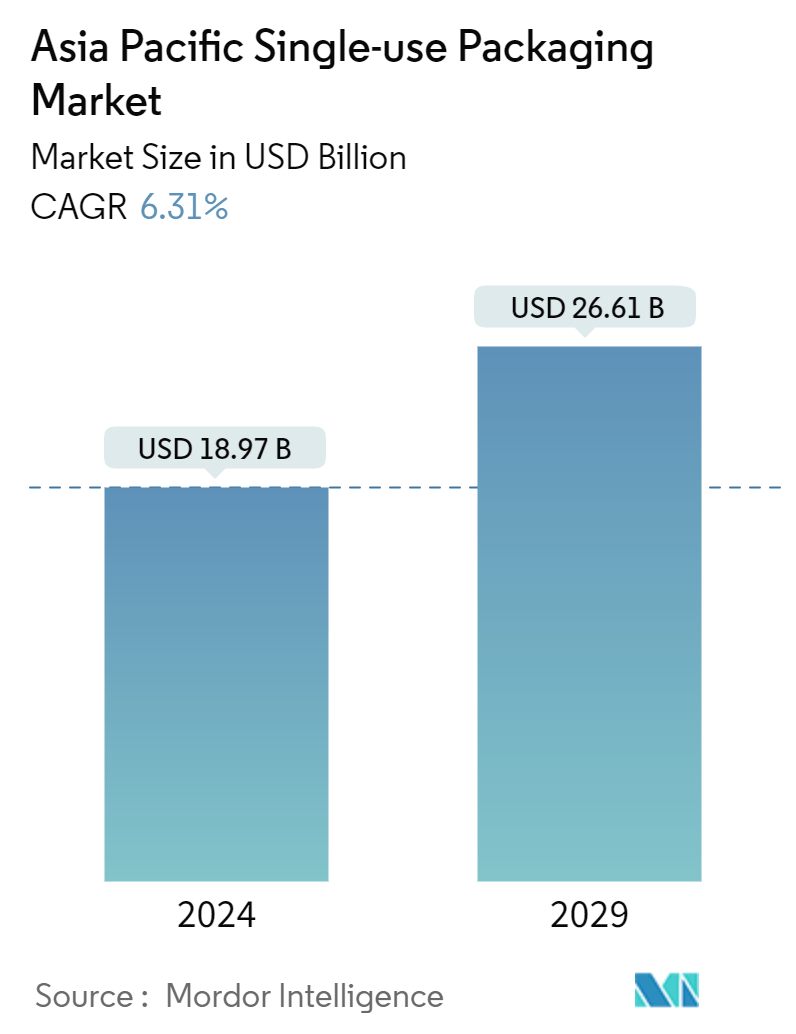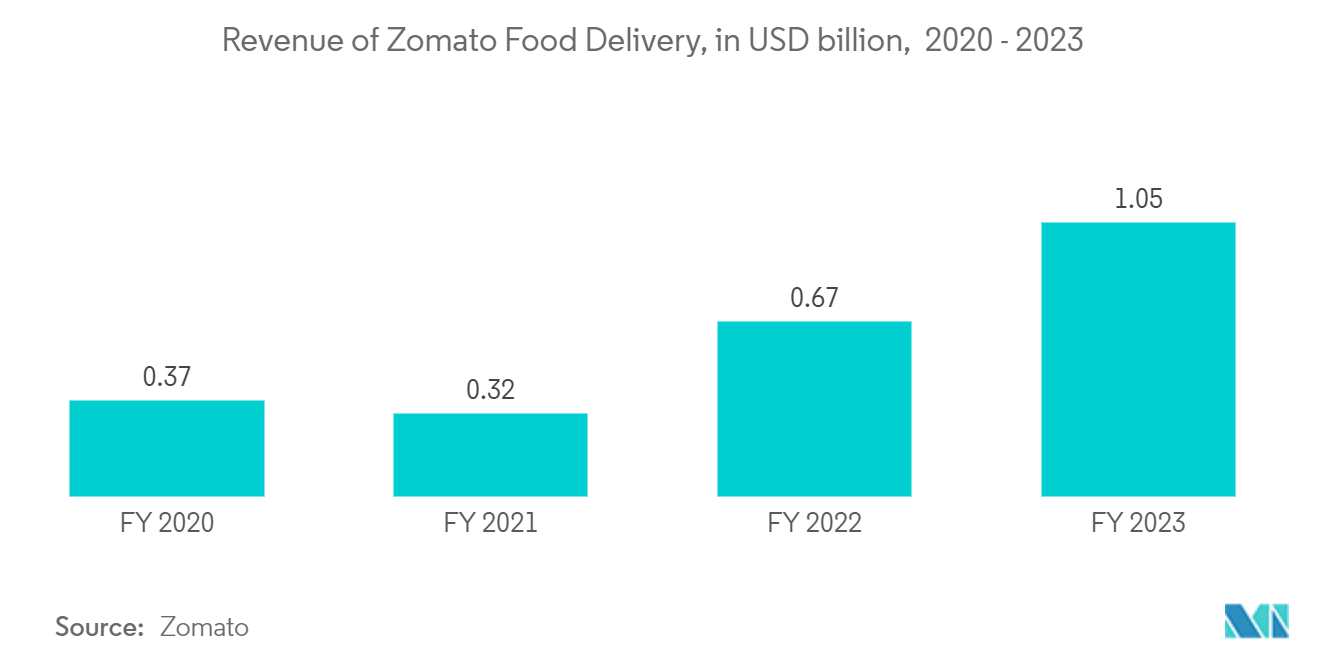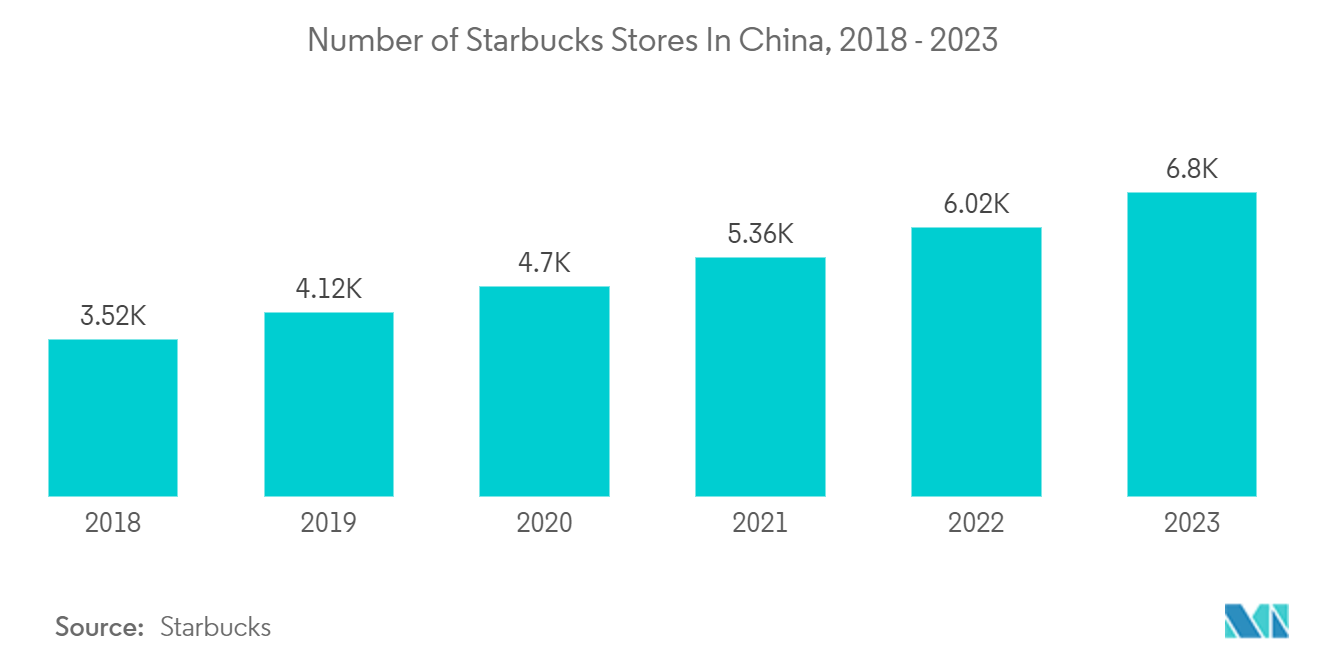Asia Pacific Single-use Packaging Market Size

| Study Period | 2019 - 2029 |
| Base Year For Estimation | 2022 |
| Market Size (2024) | USD 18.97 Billion |
| Market Size (2029) | USD 26.61 Billion |
| CAGR (2024 - 2029) | 6.31 % |
| Market Concentration | Low |
Major Players.webp)
*Disclaimer: Major Players sorted in no particular order |
Asia Pacific Single-use Packaging Market Analysis
The Asia Pacific Single-use Packaging Market size is estimated at USD 18.97 billion in 2024, and is expected to reach USD 26.61 billion by 2029, growing at a CAGR of 6.31% during the forecast period (2024-2029).
- The global economy is expected to slow as rising interest rates weigh on growth and Russia's war in Ukraine worsens the situation. Inflation remains high, and banking turmoil in the United States and Europe has added more uncertainty to an already complicated economic environment. Asia's domestic demand has remained resilient despite monetary tightening, but external demand for technology and other exports is cooling. According to the International Monetary Fund, Asia will account for about 70% of global economic growth this year as the region's expansion accelerates to around 4.6% compared to 3.8% last year.
- In Asia-Pacific, there are many densely populated countries and emerging economies where food services are in high demand, such as China and India. As a result, the demand for single-use food packaging is on the rise, and it is expected to become the most popular type of packaging in the region over the next few years.
- Plastic has always been a key component of the food packaging industry, which is the basis of the consumer's convenience culture. Due to their low cost and high performance, many food service and packaging applications have switched to plastics instead of traditional packaging materials such as corrugated paper boards, glass, and metals. The region is expected to grow in packaging products for out-of-home and on-the-go food and beverage products that are usually required in large quantities. For instance, single-use packaging is used in the region for various applications for drinking water, tea, coffee, trays, and cutleries in quick-service restaurants and institutional end users.
- Further, the region is one of the major investors and adopters of the single-use packaging market, owing to many end-user industry organizations. The growing trend of packed meals, the increasing number of restaurants and supermarkets, and increasing bottled water and beverage consumption are significant driving factors of the regional market's growth.
- In addition, the packaging industry in India and China is growing at a rapid pace. This is due to the introduction of multiple manufacturing units, environmentally friendly materials, and increased emphasis on R&D. The result is attractive and innovative products that are produced locally at an affordable price. Government initiatives such as 'Make in India' are also expected to accelerate the growth of the packaging industry.
- As a result of the response to the pandemic, consumer behavior significantly changed. Buyers are more concerned about packaging contamination, hygiene, and sustainability than before. During the pandemic, consumer behavior is expected to become more inclined toward using single-use packaging such as disposable boxes, cutlery, cups, and packages. Consumers' dynamic needs and focused approach toward the type of packaging will remain even after the pandemic. Therefore, the post-pandemic future for single-use packaging in Asia looks promising in terms of demand.
- The widespread use of plastic materials in the region has posed a considerable threat to the environment, and governments and global regulatory bodies are taking steps to address this issue. To address this issue, countries such as India have banned the production, import, storage, distribution, sale, and use of identified single-use plastic products, which are of low utility and have a high littering potential.
- The list of prohibited items includes earbuds containing plastic sticks, plastic sticks for balloons, plastic flags, candy sticks, ice-cream sticks, thermocol for decoration, plastic plates, cups, glasses, cutlery, forks, and stirrers. Spoons, knives, straws, trays, wrapping or packing films surrounding sweet boxes, invitation cards, cigarette packets, and plastic or PVC banners, all smaller than 100 microns.
Asia Pacific Single-use Packaging Market Trends
Quick Service Restaurants are Expected to Hold a Significant Share in the Market
- Cafe chains are growing faster than QSRs in India because young, aspirational consumers prefer to meet and socialize in cafes despite the high menu prices. For instance, Tim Hortons in India is part of a joint venture with AG Cafe. Gateway Partners, an investment manager, and Apparel Group, a retail and fashion conglomerate, own AG Cafe. The company plans to open 120 new stores in India by 2026.
- Further, Tata Starbucks (TST), a Starbucks-Tata Consumer Products joint venture, announced on January 2024 that it plans to open 1,000 new cafes in India by 2028 and will double its workforce. This comes when local chains are competing fiercely. Tata Starbucks has been operating in India since October 2012, when it opened its first cafe, and has so far opened 390 stores. It has added 57 stores this fiscal year, while it had 71 stores in the previous year. Tata Starbucks plans to expand its presence in tier-2 and tier-3 cities across India and expand its number of drive-through, airport, and 24/7 cafes.
- In recent years, the food industry has undergone a major transformation. Consumers can order food online and have it shipped to their residences quickly. As a result of the alterations made to the food delivery industry, most customer orders are now being placed directly from restaurants' applications or websites. As a result, restaurants and other food establishments manage digital ordering and food delivery in various ways. Some are doing it independently, while there has been an increase in the use of third-party platforms such as Uber Eats, Swiggy, and Zomato.
- The digital age culture has increased the number of people ordering and delivering food online. This is mainly because Millennials and Generation Z are used to ordering most of their food online. As more people in this region adopt this trend, the size of the online order and food delivery market is increasing. For instance, Zomato is one of India's leading online food and grocery delivery partners, and the company's revenue expanded to USD 1.05 billion in 2023 from USD 0.37 billion in 2020. As a result, the single-use packaging market is recognizing the evolution of the market and adapting accordingly.
- The need for online food delivery has grown significantly as India and China continue to urbanize and citizens embrace a modern lifestyle. Significant companies are striving to meet this increasing demand and capitalize on it. When making an order, customers are mindful of the affordability of joint food, and the rising demand for online delivery coupled with clean food packaging conditions will ensure the success of single-use packaging products in the region.

China is Expected to Hold a Significant Share in the Market
- The fast-food sector in China has experienced considerable expansion in recent years due to a combination of urbanization, growing demographic of young consumers with a sedentary lifestyle, and changing dietary preferences. Beijing's ongoing efforts to liberalize the market have further amplified this growth, providing a lucrative market for foreign investment.
- Packaging has always played an important role in the success of food and beverages. The Chinese packaging industry is affected by increasing per capita income, the changing social environment, and changing demographics. New packaging materials, processes, and forms are needed.
- Single-use food service packaging in QSRs has become vital to a globally fast-paced life. Single-use packaging allows food service establishments to package meals in a sensible, safe, and cost-effective manner while providing customers with a convenient and efficient way to transport meals. In China, QSR brands are increasing the number of outlets. KFC has 9,650 outlets as of April 2023. McDonald's, Subway, Domino's Pizza, Burger King, and Taco Bell have 5,746, 613, 613, and 1,494 outlets, respectively. At the beginning of the 2000s, several domestic fast-food brands began to enter the Chinese market, providing Chinese-style cuisine with a contemporary twist. Examples of such brands include Dicos, Yonghe King, and Ajisen Ramen.
- In addition to coffee, Starbucks has been diversifying its menu offerings to include a broader range of food items, including pastries, sandwiches, and wraps, to expand its presence in the rapidly growing fast-food sector. Due to the diversification of the menu, the company uses single-use boxes, clamshells, and paper cups. Furthermore, Starbucks stores in China reached 6,804 in 2023, significantly increasing from 3,521 stores in 2018.
- With the increasing number of Chinese consumers entering the middle class, international fast-food chains have the potential to experience considerable growth. The Chinese delivery and online ordering market continues to expand, and many Chinese fast-food establishments are adapting their operations to meet the changing needs of their customers. Many are investing heavily in digital marketing initiatives and adapting environmentally friendly single-use packaging to facilitate QSR and online ordering.

Asia Pacific Single-use Packaging Industry Overview
The Asia-Pacific single-use packaging market is fragmented, with several global and regional players, such as Berry Global Inc., Amcor Group GmbH, Huhtamäki Oyj, and Hotpack Packaging Industries LLC, vying for attention in this contested market space. This market is characterized by low product differentiation, growing product penetration, and high competition.
- August 2023 - Amcor, a global player in developing and manufacturing sustainable packaging solutions, announced the acquisition of Phoenix Flexibles, adding capacity to the fast-growing Indian market. Phoenix Flexibles has a plant in Gujarat, India, and generates around USD 20 million in annual revenue from flexible packaging sales for applications such as food, home care, and personal care.
Asia Pacific Single-use Packaging Market Leaders
-
Berry Global Inc
-
Amcor Group GmbH
-
Huhtamäki Oyj
-
Hotpack Packaging Industries LLC
-
Graphic Packaging International, LLC
*Disclaimer: Major Players sorted in no particular order
.webp)
Asia Pacific Single-use Packaging Market News
- August 2024 -Berry Global Group has announced that their B Circular line of beauty and personal care packaging is now available with CleanStream recycled plastic, improving their sustainability image and providing brands with greener packaging options. Berry's exclusive CleanStream technology recycles approximately 40% of polypropylene (PP) waste gathered from homes in the UK.
- July 2024 - Australian ag-tech company Wandarra and German packager Papacks are joining forces to transform the packaging industry across Australia and the Asia-Pacific region by reducing plastic waste. The partnership will leverage Wandarra’s access to hemp supplies with Papacks’ modern production technologies. The collaboration between Wandarra and Papacks plans to advance Australia’s circular packaging economy.
Asia Pacific Single-use Packaging Market Report - Table of Contents
1. INTRODUCTION
- 1.1 Study Assumptions and Market Definition
- 1.2 Scope of the Study
2. RESEARCH METHODOLOGY
3. EXECUTIVE SUMMARY
4. MARKET INSIGHTS
- 4.1 Market Overview
-
4.2 Industry Attractiveness - Porter's Five Forces Analysis
- 4.2.1 Bargaining Power of Suppliers
- 4.2.2 Bargaining Power of Buyers
- 4.2.3 Threat of New Entrants
- 4.2.4 Threat of Substitutes
- 4.2.5 Intensity of Competitive Rivalry
- 4.3 Industrial Value Chain Analysis
5. MARKET DYNAMICS
-
5.1 Market Drivers
- 5.1.1 Ongoing Trend of Online Food Delivery Services
- 5.1.2 Increasing Number of Quick-Service Restaurants
-
5.2 Market Restraints
- 5.2.1 Regulations Toward the Use of Plastics for Single Use Packaging
6. MARKET SEGMENTATION
-
6.1 By Material Type
- 6.1.1 Paper and Paperboard
- 6.1.2 Plastic
- 6.1.3 Glass
- 6.1.4 Other Material Types
-
6.2 By End-user Industry
- 6.2.1 Food
- 6.2.2 Beverage
- 6.2.3 Personal Care
- 6.2.4 Pharmaceutical
- 6.2.5 Other End-user Industries
-
6.3 By Country***
- 6.3.1 China
- 6.3.2 Japan
- 6.3.3 India
- 6.3.4 Australia and New Zealand
7. COMPETITIVE LANDSCAPE
-
7.1 Company Profiles
- 7.1.1 Berry Global Inc.
- 7.1.2 Amcor Group GmbH
- 7.1.3 Huhtamaki Oyj
- 7.1.4 Hotpack Packaging Industries LLC
- 7.1.5 Graphic Packaging International LLC
- 7.1.6 Detpak - Detmold Group
- 7.1.7 Sonoco Products Company
- 7.1.8 Oji Holdings Corporation
- 7.1.9 Zhejiang Pando EP Technology Co.
- *List Not Exhaustive
8. INVESTMENT ANALYSIS
9. FUTURE OF THE MARKET
** Subject To AvailablityAsia Pacific Single-use Packaging Industry Segmentation
Single-use packaging is a type of packaging that is intended for single-use and then for disposal immediately. Plastic is the most widely used material in packaging and medical applications due to its versatility, ease of production, safety, sterility, and cost-effectiveness, followed by paper. Single-use plastic packaging includes grocery bags, cardboard boxes, bottles, food containers, straws, coffee stirrers, disposable cups, and cutlery.
The Asia-Pacific single-use packaging market is segmented by material type (paper and paperboard, plastic, glass, and other materials), by end user (food, beverage, personal care, pharmaceutical, and other end users), and by country (China, Japan, India, Australia and New Zealand, and Rest of Asia-Pacific). The market sizes and forecasts are provided in terms of value (USD) for all the above segments.
| By Material Type | Paper and Paperboard |
| Plastic | |
| Glass | |
| Other Material Types | |
| By End-user Industry | Food |
| Beverage | |
| Personal Care | |
| Pharmaceutical | |
| Other End-user Industries | |
| By Country*** | China |
| Japan | |
| India | |
| Australia and New Zealand |
Asia Pacific Single-use Packaging Market Research FAQs
How big is the Asia Pacific Single-use Packaging Market?
The Asia Pacific Single-use Packaging Market size is expected to reach USD 18.97 billion in 2024 and grow at a CAGR of 6.31% to reach USD 26.61 billion by 2029.
What is the current Asia Pacific Single-use Packaging Market size?
In 2024, the Asia Pacific Single-use Packaging Market size is expected to reach USD 18.97 billion.
Who are the key players in Asia Pacific Single-use Packaging Market?
Berry Global Inc, Amcor Group GmbH, Huhtamäki Oyj, Hotpack Packaging Industries LLC and Graphic Packaging International, LLC are the major companies operating in the Asia Pacific Single-use Packaging Market.
What years does this Asia Pacific Single-use Packaging Market cover, and what was the market size in 2023?
In 2023, the Asia Pacific Single-use Packaging Market size was estimated at USD 17.77 billion. The report covers the Asia Pacific Single-use Packaging Market historical market size for years: 2019, 2020, 2021, 2022 and 2023. The report also forecasts the Asia Pacific Single-use Packaging Market size for years: 2024, 2025, 2026, 2027, 2028 and 2029.
Asia Pacific Single-use Packaging Industry Report
Statistics for the 2024 Asia Pacific Single-use Packaging market share, size and revenue growth rate, created by Mordor Intelligence™ Industry Reports. Asia Pacific Single-use Packaging analysis includes a market forecast outlook for 2024 to 2029 and historical overview. Get a sample of this industry analysis as a free report PDF download.



